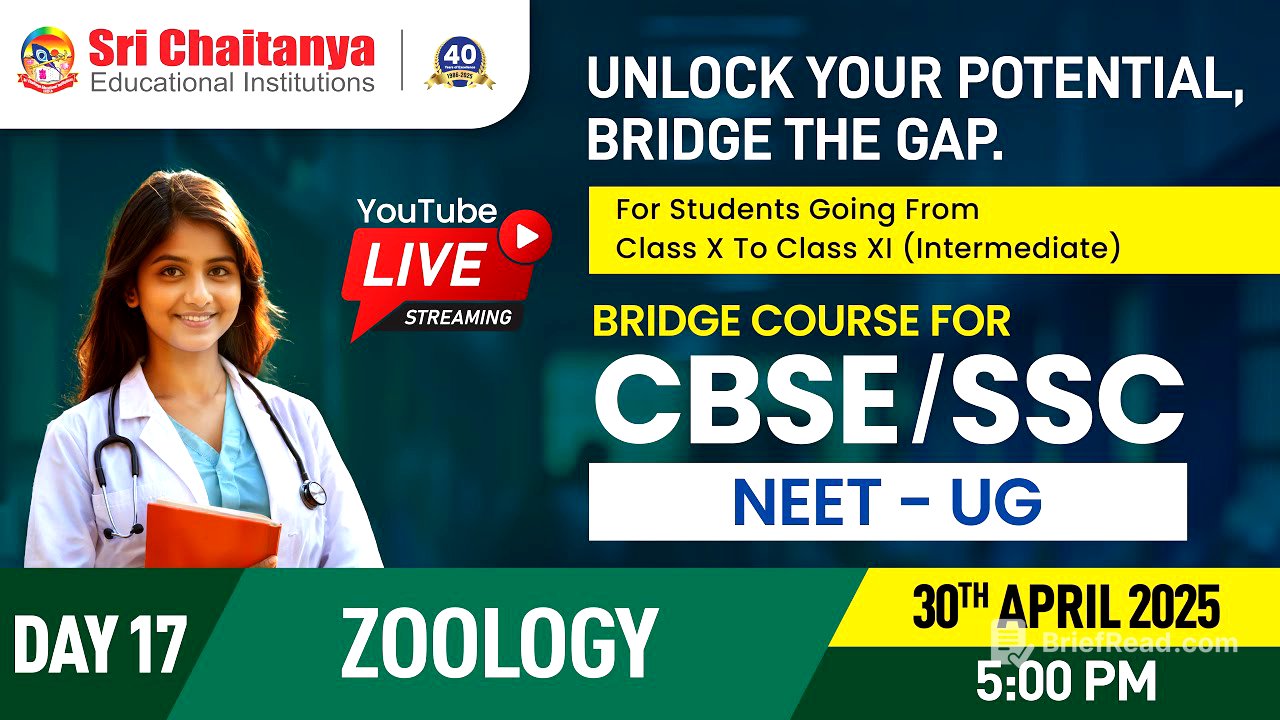TLDR;
This session is a part of the NEET bridge course focusing on zoology, specifically the animal kingdom. The lecture covers metamorphosis (direct and indirect development), reproductive cycles in mammals (estrous and menstrual cycles), and an introduction to Phylum Porifera (sponges). Key points include understanding the differences between complete and incomplete metamorphosis, distinguishing between estrous and menstrual cycles based on presence in primates vs. non-primates and uterine shedding, and the characteristics of porifera like their water canal system and body structure.
- Metamorphosis: Direct vs. Indirect Development
- Reproductive Cycles: Estrous vs. Menstrual
- Phylum Porifera: Characteristics and Water Canal System
Introduction [0:01]
Dr. Anisha welcomes students to a zoology class as part of the NEET bridge 2025 course, designed to help students with their NEET 2027 exams. The class aims to cover important zoology topics that might be missed in regular classes, focusing on key concepts that will be beneficial for the actual NEET examinations. The session continues the discussion on the animal kingdom, particularly focusing on life processes like respiration, movement, and circulation.
Metamorphosis: Direct and Indirect Development [1:52]
The discussion transitions to metamorphosis, a process of indirect development where organisms undergo gradual changes from a fertilized egg to a larva, then a pupa, and finally an adult. This contrasts with direct development, where the organism emerges as a miniature adult, as seen in reptiles and birds. Frogs, for example, exhibit indirect development with a tadpole larval stage. Metamorphosis involves significant structural and physiological changes, where the larval stage differs markedly from the adult form in terms of feeding habits, movement, and habitat.
Types of Metamorphosis: Complete vs. Incomplete [6:55]
Metamorphosis is categorised into complete and incomplete types. Complete metamorphosis includes all life cycle stages: egg, larva, pupa, and adult, with each stage differing significantly. Incomplete metamorphosis, however, involves the egg developing into multiple larval stages (nymphs) without a pupa stage, eventually leading to the adult form. Examples of complete metamorphosis include butterflies, dragonflies, ants, bees, wasps and silkworms, while incomplete metamorphosis is seen in cockroaches and praying mantises.
Reproductive Cycles in Mammals: Estrous vs. Menstrual [11:17]
The lecture introduces reproductive cycles in mammalian females, distinguishing between the estrous cycle, found in non-primate mammals like cows, dogs, and horses, and the menstrual cycle, characteristic of primate females such as chimpanzees, gorillas, orangutans, and humans. A key difference is that the estrous cycle does not involve endometrial shedding and includes an anestrus phase (a gap), whereas the menstrual cycle involves uterine shedding and is continuous without gaps. During the estrous cycle, females experience a "heat period" due to increased estrogen levels, which is their breeding period.
Phylum Porifera: General Characteristics [20:11]
The session introduces Phylum Porifera (sponges), characterised as pore-bearing organisms. These organisms have numerous pores (osteia) all over their body, which are essential for their functions. Most poriferans are sedentary (non-motile) and live in warm aquatic environments, either freshwater or marine. They exhibit a cellular level of organisation and are mostly asymmetric. Their body plan is a cell aggregate plan, and they are diploblastic, having only two germ layers (ectoderm and endoderm). As such, they are also acoelomate, lacking a true body cavity.
Water Canal System in Porifera [32:10]
A key characteristic of porifera is their water canal system, which includes small pores (osteia) and a large pore (osculum), with the internal body space called the spongocoel. Water enters through the osteia, circulates in the spongocoel, and exits through the osculum. This system is crucial for bringing food and respiratory gases into the body, as well as for excretion and sexual reproduction. The water canal system facilitates nutrition, respiration, excretion, and sexual reproduction by bringing sperm from other organisms.
Examples of Sponges [39:19]
Examples of sponges include Sycon (also known as Scypha or urn sponge), Spongilla (freshwater sponges), and Euspongia (bath sponge). These examples are important from an examination point of view. The lecture concludes with a thank you and encouragement to students to continue studying and stay healthy, with a promise to cover more phyla in the next class.
